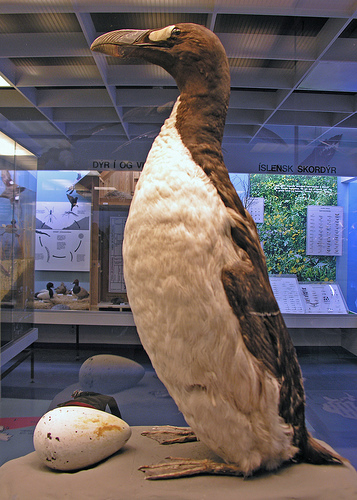Thus for Book Beginnings on Friday, hosted by Rose City Reader, all I have is a nonfiction work. Here is the start of the Prologue of The Sixth Extinction by Elizabeth Kolbert
Beginnings, it's said, are apt to be shadowy. So it is with this story, which starts with the emergence of a new species maybe two hundred thousand years ago. The species does not yet have a name – nothing does – but it has the capacity to name things.
As with any young species, this one's position is precarious. Its numbers are small, and its range is restricted to a slice of eastern Africa. Slowly its population grows, but quite possibly then it contracts again – some would claim near fatally – to just a few thousand pairs.
The members of the species are not particularly swift or strong or fertile. They are, however, singularly resourceful.
For The Friday 56 hosted at Freda's Voice here is a bit from page 56 of The Sixth Extinction ...
The Icelandic Institute of Natural History occupies a new building on a lonely hillside outside Reykjavik. The building has a tilted roof and is designed as a research facility, with no public access, which means that a special appointment is needed to see any of the specimens in the institute's collection. These specimens, as I learned on the day of my own appointment, include: a stuffed tiger, a stuffed kangaroo, and a cabinet full of stuffed birds of paradise.
The reason I'd arranged to visit the institution was to see its great auk. Iceland enjoys the dubious distinction of being the bird's last known home, and the specimen I'd come to look at was killed somewhere in the country – no one is sure of the exact spot – in the summer of 1821. The bird's carcass was purchased by a Danish count, Frederik Christian Raben, who had come to Iceland expressly to acquire an auk for his collection (and nearly drowned in the attempt). Raben took the specimen home to his castle, and it remained in private hands until 1971, when it came up for auction in London. The Institute of Natural History solicited donations, and within three days Icelanders contributed the equivalent of ten thousand British pounds to buy the awk back. (One woman I spoke to, who was ten years old at the time, recalled emptying her piggy bank for the effort.) Icelandair provided two free seats for the homecoming, one for the institute's director and the other for the boxed bird.
Ohh - this needs pictures !
 |
| Icelandic Institute of Natural History |
 |
Count Raben's Great Auk with egg (Bird no. 49) at the
Icelandic Natural History Museum in Reykjavík.
From http://www.extinct-website.com/
© Reproduced on Extinct Website by
kind permission of Bruce Aleksander & Dennis Milam
Icelandic Natural History Museum in Reykjavík.
From http://www.extinct-website.com/
© Reproduced on Extinct Website by
kind permission of Bruce Aleksander & Dennis Milam
Have a great weekend !

This sounds like a fascinating book! I don't often read nonfiction, but this sounds like a true-life book that I'd enjoy.
ReplyDeleteMy Friday post features A DARK & STORMY KNIGHT.
Sounds interesting and the pictures are fantastic. I'd love to go to that museum. And really Iceland in general. Thanks for sharing!
ReplyDeleteWhat a wonderful beginning. I'm thinking it refers to early man. I find it hard to fathom the many species that have gone extinct. How lonely it was for that last one.
ReplyDeleteMy 56 - http://fuonlyknew.com/2015/01/30/the-friday-56-50-strings/
This sounds brilliant! I'm going to add this to my tbr. :)
ReplyDeleteCheck out my 56.
Very cool! I think the history in it is appealing! Iceland is on my bucket list too!
ReplyDeleteHappy weekend!
I read an essay by Kolbert, and it made me very much want to read her whole book. She sounds like she has many important and fascinating things to say.
ReplyDelete